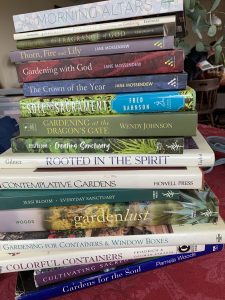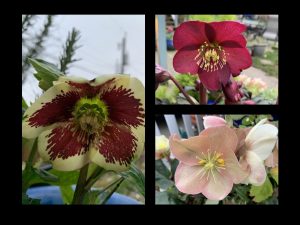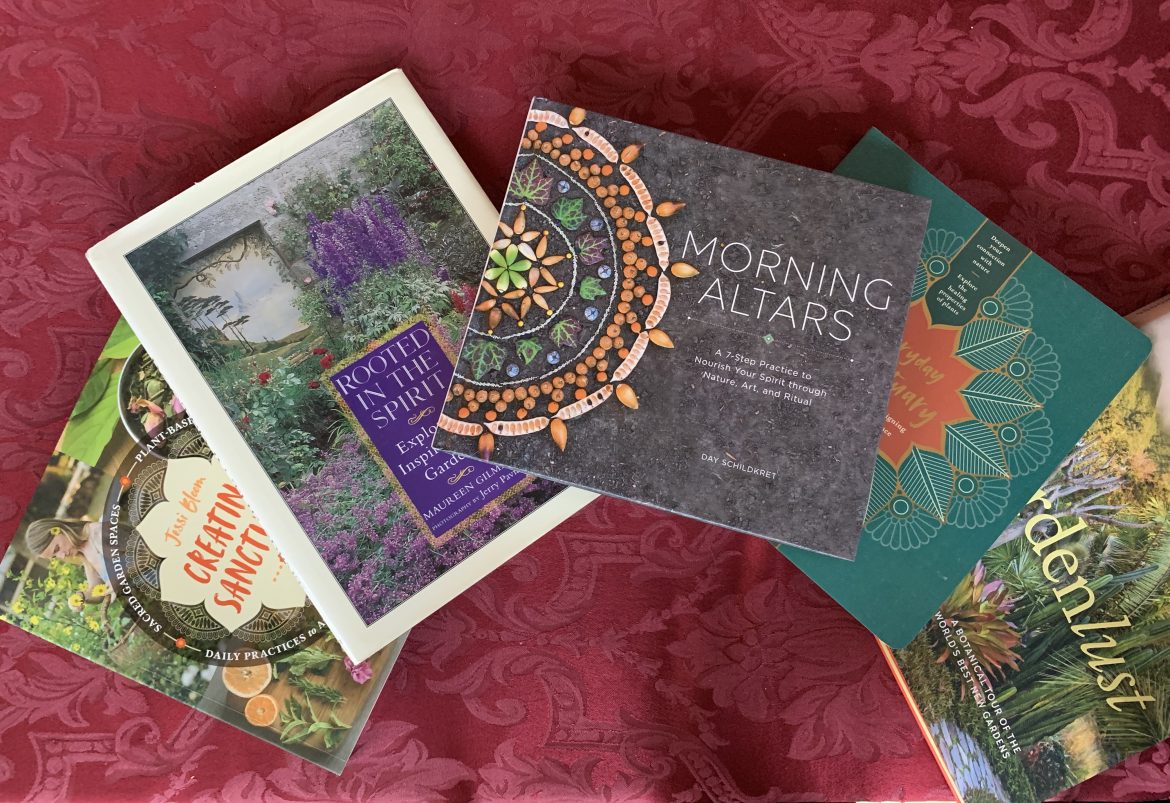January is my dreaming month – not just for my life but also for my garden. This year I am really into the rhythm as I am not only planning a garden but am also thinking about a new book project on rhythms and seasons. I received a couple of wonderful books for Christmas, a few more in anticipation of my birthday next week and another few that I pulled off my shelves. So I have quite a stack of reading to keep me busy in the snowy weather we are expecting next week.

Rhythms and seasons – a lot of books to read.
My dreaming also encourages me to go outside and look at my garden and at the neighborhood with fresh eyes. This has been motivated by the book that is on the top of my pile Morning Altars by Day Schildkret. Talk about a treasure. Not only a feast of images but also of words, in many places language that had me wishing again that I read this book before writing The Gift of Wonder. No wonder I want to write another book. My initial foray into the life of children has left me thirsting for more and it is books like this that open my eyes even further to that wide eyed wonder we need to be rebirth into.
Schildkret describes a 7 step process for creating a morning altar that begins with exercising our capacity “to be enamored by the ordinary and to behold the insignificant”, a process that he explains begins with learning once more to recognize the wealth of beauty and wonder littered all around us by regaining the effortless seeing of childhood where everything is a playground and we can spend hours playing in the sand and chasing butterflies.
His steps are not only good for creating morning altars. They create a wonderful ritual of discovery, creativity and sharing and letting go that the seasons of the year also beckon us towards. So I have adapted Schildkret’s steps – leaving out some and changing others so that they are more flexible not just for creating art and ritual but for my exploration of the natural world in all its dimensions.
- Wander and Wonder: As Schildret suggests this is indeed a treasure hunt, a little like the gratitude scavenger hunt we examined last year. Yesterday, I walked around my wintery garden and noticed for the first time that all my hellebores are flowering. These are the queens of the winter garden here in Seattle. Such a delight and I almost missed them. Where is God calling you to wander today searching for hidden treasure?
- Place: “Practice listening to the place that calls you…witness the place come alive as it might have never before.” For me, this was a very profound step. Looking around my neighborhood in particular and the path that Tom and I walk 4 or 5 times a week up to and around the local reservoir park as though it were the first time I have ever walked, it is very special. I notice trees and gardens, mountain vistas and fellow walkers in ways that I have never noticed them before. Most special of all, I notice them as part of the unique landscape of this season, a special gift from God to me to be embraced for this short period of time. What special place calls to you as part of the unique landscape of this season?
- Create: Here, Schildkret talks about creating patterns and nature art but for me this creation step extends to whatever form of creative expression God is wanting to birth at this time. It might be an art form. It might just as easily be a song, a poem or a painted rock. What form of creative expression bubbles up from within you as a way to express the awe and wonder of your wandering?
- Share: As Schildkret suggests photographing and sharing your creations is a way of gifting it to the world. Obviously these days places like Instagram, Pinterest and Facebook make this form of sharing easy, but you might like to restrict your sharing to family and friends in more intimate ways. How could you share your creative work in order to bless those around you?
- Let Go. “Practice walking away”. This is such important advice. The impermanence of each day, season and moment is a reality we rarely like to face. But accepting and incorporating this impermanence in our rituals enables us to embrace change in a healthy and liberating way. At the end of each season, I like to think about the blessings it has brought and the joy it has created. Then I let go, turning towards the next season and the anticipation I have of the new perspectives, blessings and joys it could hold. What habits or rituals help you to walk away from the season that are past and anticipate the ones that are coming?

Hellebores in bloom – the queens of the winter garden

